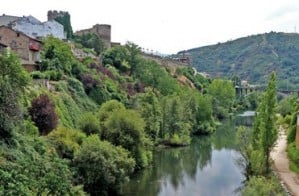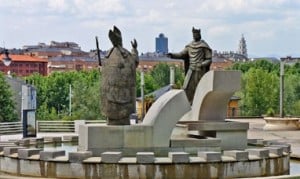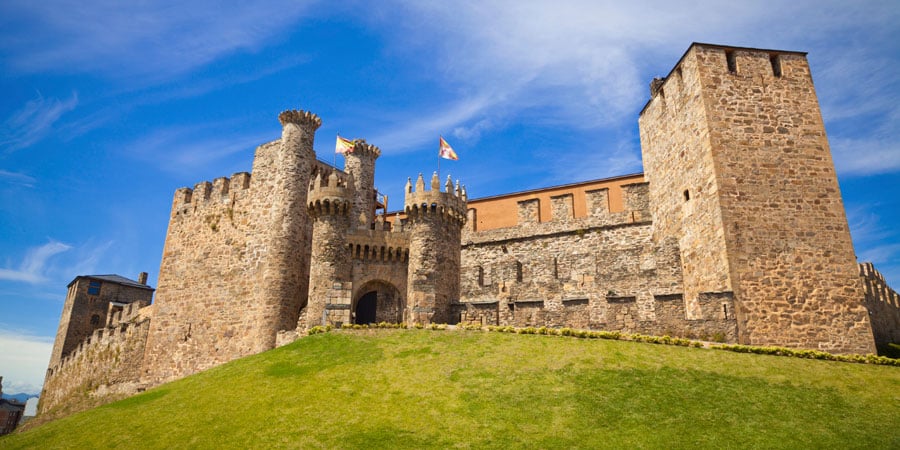The city of Ponferrada, located on the Camino Francés, has a history deeply tied to the Camino de Santiago. From its very beginnings, the town grew and developed as a settlement that welcomed pilgrims travelling westward towards Santiago de Compostela. The story of Ponferrada is inseparable from the famous bridge that gave the city its name.
Table of contents
The Bridge that Shaped a City
In the 11th century, Bishop Osmundo of Astorga recognised the difficulties pilgrims faced when trying to cross the Sil River on their journey. To provide them with safe passage, he ordered the construction of a bridge. This crossing became essential, easing the way for countless travellers heading to Santiago.
Later, iron reinforcements were added to strengthen the structure, and it was from this feature that the town derived its name. Ponferrada comes from the Latin Pons Ferrata, meaning “Iron Bridge”. What began as a practical solution to support pilgrims soon became the foundation for a thriving settlement.

From a Village to a Growing Settlement
Around the newly built bridge, a small community developed. The first village was known as “Puebla de San Pedro” or “Saint Peter’s village”, named after a church dedicated to Saint Peter that was built in the 12th century close to the crossing.
Across the river, on a rocky hill, another settlement was established by King Fernando III of León. This site would later grow into a stronghold and, eventually, the impressive Templar castle that dominates Ponferrada’s skyline today. The bridge thus acted not only as a point of connection for pilgrims but also as a meeting place for communities that would shape the city’s future.
The Arrival of the Templars
The 12th century marked a significant chapter in Ponferrada’s history. During this time, the Order of the Knights Templar, a military and religious group known for their role in protecting Christian pilgrims, became established in the region.
King Alfonso IX of León donated the town of Ponferrada to the Templars. Their role was to ensure the safety of those travelling along the Camino de Santiago, protecting them from dangers on the road. The Templars built fortifications and expanded their influence, leaving behind an enduring legacy in the form of Ponferrada’s grand castle.
This fortress became a home to monks, knights, and feudal lords, while also serving as a symbol of protection and authority along the Camino. For pilgrims, it offered reassurance that their journey through this part of Spain was guarded.

Ponferrada’s Legacy and Setting
Over time, the settlement expanded, blending together the early village of San Pedro, the hilltop fortifications, and the surrounding lands. What began as a small riverside crossing grew into a bustling town, serving not just pilgrims but also merchants, farmers, and travellers moving through the fertile El Bierzo valley.
Today, Ponferrada stands as the largest city in the region and the last major urban centre on the French Way before reaching Santiago de Compostela. Surrounded by mountains and vineyards, it offers a unique combination of history, culture, and natural beauty.
Ponferrada as a Starting Point for Pilgrims
For many modern-day travellers, Ponferrada is more than a stop along the Camino – it is also the starting point of their pilgrimage. Walking or cycling the final 200 kilometres from Ponferrada to Santiago qualifies pilgrims to receive the Compostela certificate upon arrival at the cathedral. This makes the city a popular choice for those wishing to experience the final stages of the journey while still meeting the official requirements. Starting here allows pilgrims to enjoy the rich history of Ponferrada before setting out across the landscapes of Galicia towards Santiago.
Ponferrada on the Camino de Santiago
Ponferrada remains an important stage on the Camino Francés. Its Templar castle, historic old town, and connections to the Iron Bridge make it a fascinating place for pilgrims and visitors alike. For many, starting the Camino from Ponferrada is an excellent choice, offering both a rich historical backdrop and a chance to experience the vibrant atmosphere of the Camino in its final stages.
The story of the Iron Bridge continues to echo in the city’s name, a reminder of the efforts made centuries ago to support travellers on their way to Santiago. Each pilgrim crossing Ponferrada today becomes part of this long tradition, walking in the footsteps of those who came before.
For more information about the Camino de Santiago routes or to book your Camino trip, contact us. Buen Camino
